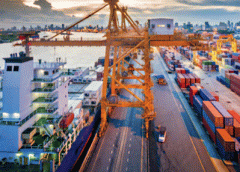Sept. 4, 2020 – Over the coming decades, the type and amount of trade carried by sea will change, influenced by climate policy as well as other economic factors. Ports will need to respond to these indirect effects of climate change as well as more direct effects of sea‐level rise, while maintaining their efficiency and reliability as part of global trade systems. Key to avoiding bottlenecks and delays is sufficient handling area within the ports. Using available guidance on the handling area needed for different goods, a new analysis by the American Geophysical Union shows that projected increases in maritime trade mean that significant new port areas will need to be constructed, in addition to adapting existing ports to relative sea‐level rise. Four climate policy‐related trade scenarios analyzed indicate that port areas may need to double or even quadruple globally by 2050. Hence, the cost of adapting to relative sea‐level rise is minimal in comparison to that of building new port areas. The need for these new port areas offers an opportunity to build climate‐resilient ports from the outset, and represents a significant construction – and aggregates – opportunity in the future.
A Report on Ports

